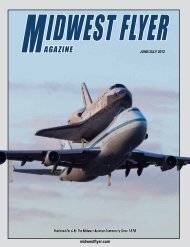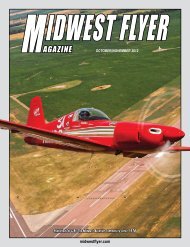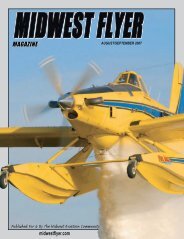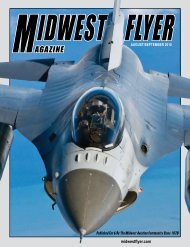minnesota - Midwest Flyer
minnesota - Midwest Flyer
minnesota - Midwest Flyer
Create successful ePaper yourself
Turn your PDF publications into a flip-book with our unique Google optimized e-Paper software.
water, by raft, rubber tire or in dugout<br />
log canoes. Each volunteer paid<br />
their own way, expected no thanks,<br />
reward or recognition, but with one<br />
united objective – find our MIAs.<br />
Two years in the planning by<br />
Bryan Moon, President of<br />
Minnesota’s MIA Hunters organization<br />
and with 19 previous mission<br />
experiences and 57 MIA discoveries<br />
under his belt. Most mission members<br />
came from the Twin Cities area, but<br />
also from Illinois, Florida, Colorado<br />
and California. Each of three groups<br />
was led into the jungle by dual mission<br />
leaders, who a year ago, survived<br />
an attack in the same jungle by hostile<br />
tribesmen and who had to be rescued<br />
from a mountain top by helicopter.<br />
First to volunteer for the new missions<br />
was Red Wing, Minnesota resident<br />
and retired president of Red<br />
Wing Shoe Company, Joe Goggin,<br />
who had fallen over a python snake<br />
on the 2006 mission and was pulled<br />
clear by native trackers. Despite this,<br />
and upon hearing of the new 2007<br />
missions, he sent a terse four-word<br />
message saying, “Bryan, let’s go.<br />
Joe.” He was joined by two veterans,<br />
John Rippinger, company president<br />
from Schaumberg, Illinois and aerobatic<br />
pilot, and Rochester, Minnesota<br />
property manager, Curt Hills, both<br />
veterans of the 1990 Doolittle bomber<br />
search in China. Taking a dominant<br />
role on all three missions, David<br />
Donkers, a pilot from Nerstrand,<br />
Minnesota provided the outdoors<br />
expertise and catering experience.<br />
With an average age of 60, the<br />
youngest member was David<br />
Donker’s daughter, Susan Donkers,<br />
21. The oldest member was<br />
Deephaven, Minnesota resident and<br />
experienced adventurer Ralph<br />
Stillman, 76, who signed up and completed<br />
two of the three missions. Each<br />
had their own reason for volunteering,<br />
but their resolve was unanimous.<br />
Just before leaving on Mission 1,<br />
St. Paul travel agent president, Karen<br />
Johnson, left note under Bryan’s door.<br />
It read, “If I die during the time of our<br />
mission, please dig a hole and bury<br />
me on site – take pictures to document<br />
for family and insurance, but go<br />
on to complete the mission.” Such<br />
was the spirit of all the volunteers.<br />
The success of mission planning<br />
leaned heavily upon a small group of<br />
Papuan trackers who joined MIA<br />
Hunters in advance to spearhead the<br />
crash site searches. It was because of<br />
their jungle know-how and determination<br />
that the initial plans to investigate<br />
as many as 10 sites was born. The<br />
same trackers then became the scouts<br />
who guided each of the MIA Hunter<br />
groups on their jungle searches and<br />
back to base camp.<br />
A total of nine jungle aircraft sites<br />
were found, mapped and inspected by<br />
the MIA Hunters. Two other sites<br />
were additionally found by scouts and<br />
the search for one site was aborted.<br />
The treatment of crash sites is sensitive.<br />
All MIA Hunters sign a pledge<br />
in advance to treat the sites as hallowed<br />
ground and not to remove anything<br />
from the wreckage. An<br />
American flag is placed on each site<br />
identified as a U.S. aircraft and a<br />
prayer offered for the deceased crew.<br />
Each site is then carefully mapped,<br />
photographed and videotaped, but<br />
otherwise left undisturbed. A detailed<br />
brief on each site is then submitted to<br />
the U.S. Army in Hawaii which has<br />
the ultimate responsibility for MIA<br />
recoveries, identification and return of<br />
remains to relatives.<br />
The removal of dog-tags is strictly<br />
forbidden by the MIA Hunters, but<br />
did not prevent scouts from handing<br />
over two dog-tags they found at a<br />
native village where reportedly there<br />
were others. Overnight, the identities<br />
of the two tags was checked and<br />
found that neither was an MIA,<br />
although why the tags were left<br />
behind is a mystery. One officer was<br />
buried in Arlington and the other died<br />
in 2002. These tags are being returned<br />
to relatives and a check is being made<br />
on other tags remaining at the same<br />
village.<br />
While MIA Hunters were engaged<br />
in multiple searches, other native<br />
scouts were penetrating into deeper<br />
jungle mountain locations. One<br />
returned with photographs of an identifiable<br />
U.S. aircraft and a second<br />
Japanese bomber with identification<br />
plates from both, plus photographs of<br />
human remains. A related, but more<br />
bizarre story was told of 10 Japanese<br />
bodies also buried nearby. The site’s<br />
location is being turned over to the<br />
U.S. Army for their examination.<br />
Not all the missions reached their<br />
target site. One group spent five hours<br />
crossing fields and in a grueling climb,<br />
which became almost vertical. Their<br />
guide, a local villager who had originally<br />
found the crash site, had reported<br />
a blond hair pilot entombed in his aircraft.<br />
But upon reaching a high crest,<br />
the villager could not remember the<br />
location of the aircraft wreckage. The<br />
group had to turn back to reach their<br />
base camp before dark. Despite this,<br />
the approximate location to the site<br />
was recorded and included in material<br />
being sent to the U.S. Army.<br />
Superstition and even fear of crash<br />
sites is not uncommon with many villagers.<br />
Some claim they hear screams<br />
in the night. Others say that the<br />
ghosts of the airmen are seen walking<br />
through the villages. Not all the<br />
claims can be discounted.<br />
In one village, the MIA Hunters<br />
were warned that to approach the site<br />
where airmen were buried, would<br />
mean that it would rain. They walked<br />
to the location and, despite a clear<br />
blue sky, it rained, and did not stop<br />
raining until they left. Another village<br />
group considered the crash site haunted<br />
for over 50 years. They would not<br />
go near it at night claiming that to do<br />
so meant the ground would tremble<br />
and loud engine noises would fill the<br />
darkness. However, since MIA<br />
Hunters found the aircraft wreckage<br />
and the two MIAs’ remains were<br />
removed, the villagers report that the<br />
jungle is now silent at night.<br />
To reach one location, the MIA<br />
Hunters crossed a river on rafts, three<br />
at a time. The village chief who was<br />
their guide explained that he had been<br />
taken as a youth by the Japanese and<br />
reared by them. Eye witnesses<br />
52 MIDWEST FLYER MAGAZINE OCTOBER/NOVEMBER 2007
















